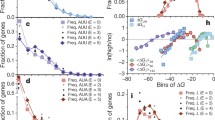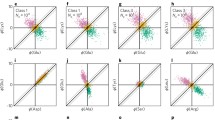Abstract
Based on the differences in synonymous codon use between E. coli and S. typhimurium, the synonymous substitution rates can be estimated. In contrast to previous studies on the substitution rates in these two organisms, we use a kinetic model that explicitly takes the selection bias into account. The selection pressure on synonymous codons for a particular amino acid can be calculated from the observed codon bias. This offers a unique opportunity to study systematically the relationship between substitution-rate constants and selection pressure. The results indicate that the codon bias in these organisms is determined by a mutation-selection balance rather than by stabilizing selection. A best fit to the data implies that the mutation rate constant increases about threefold in genes at low expression levels relative to those that are highly expressed.
Similar content being viewed by others
References
Berg OG (1992) The evolutionary selection of DNA base pairs in gene-regulatory binding sites. Proc Natl Acad Sci U S A 89:7501–7505
Berg OG (1995a) Kinetics of synonymous codon change for an amino acid of arbitrary degeneracy. J Mol Evol (in press)
Berg OG (1995b) Periodic selection and hitchhiking in a bacterial population. J Theor Biol (in press)
Bulmer M (1987) Coevolution of codon usage and transfer RNA abundance. Nature 325:728–730
Bulmer M (1988a) Codon usage and intragenic position. J Theor Biol 133:67–71
Bulmer M (1988b) Are codon usage patterns in unicellular organisms determined by selection mutation balance? J Evol Biol 1:15–26
Bulmer M (1990) The effect of context on synonymous codon usage in genes with low codon usage bias. Nucleic Acids Res 18:2869–2873
Bulmer M (1991) The selection-mutation drift theory of synonymous codon usage. Genetics 129:897–907
Ehrenberg M, Kurland CG (1984) Costs of accuracy determined by a maximal growth rate constant. Q Rev Biophys 17:45–82
Emilsson V, Kurland CG (1990) Growth rate dependence of transfer RNA abundance in Escherichia coli. EMBO 19:4359–4366
Emilsson V, Näslund AK, Kurland CG (1993) Growth-rate dependent accumulation of twelve tRNA species in Escherichia coli. J Mol Biol 230:483–491
Eyre-Walker A, Bulmer M (1993) Reduced synonymous substitution rate at the start of enterobacterial genes. Nucleic Acids Res 21: 4599–4603
Ikemura T (1981) Correlation between the abundance of Escherichia coli transfer RNAs and the occurrence of the respective codons in its protein genes. J Mol Biol 146:1–21
Ikemura T (1985) Codon usage and tRNA content in unicellular and multicellular organisms. Mol Biol Evol 2:13–34
Kimura M (1980) A simple method for estimating evolutionary rates of base substitutions through comparative studies of nucleotide sequences. J Mol Evol 16:111–120
Kimura M (1981) Possibility of extensive neutral evolution under stabilizing selection with special reference to nonrandom usage of synonymous codons. Proc Natl Acad Sci USA 78:5773–5777
Kimura M (1983) The neutral theory of evolution. Cambridge University Press, Cambridge, pp 183–193
Li WH, Wu CI, Luo CC (1985) A new method for estimating synonymous and nonsynonymous rates of nucleotide substitution considering the relative likelihood of nucleotide and codon changes. Mol Biol Evol 2:150–174
Li WH, Graur D (1991) Fundamentals of molecular evolution. Sinauer Associated, Sunderland, MA p 32
Ochman H, Wilson AC (1987) Evolutionary history of enteric bacteria. In: Neidhardt FC (ed) Escherichia coli and Salmonella typhimurium: cellular and molecular biology. ASM Press, Washington, DC, p 1649
Selby CP, Sancar A (1993) Transcription-repair coupling and mutation frequency decline. J Bacteriol 175:7509–7514
Sharp PM (1991) Determinants of DNA sequence divergence between Escherichia coli and Salmonella typhimurium: codon usage, map position, and concerted evolution. J Mol Evol 33:23–33
Sharp PM, Li WH (1987) The rate of synonymous substitution in enterobacterial genes is inversely related to codon usage bias. Mol Biol Evol 4:222–230
Sueoka N (1962) On the genetic basis of variation and heterogeneity of DNA base composition. Proc Natl Acad Sci USA 48:582–592
Author information
Authors and Affiliations
Additional information
Correspondence to: O.G. Berg
Rights and permissions
About this article
Cite this article
Berg, O.G., Martelius, M. Synonymous substitution-rate constants in Escherichia coli and Salmonella typhimurium and their relationship to gene expression and selection pressure. J Mol Evol 41, 449–456 (1995). https://doi.org/10.1007/BF00160316
Received:
Accepted:
Issue Date:
DOI: https://doi.org/10.1007/BF00160316




